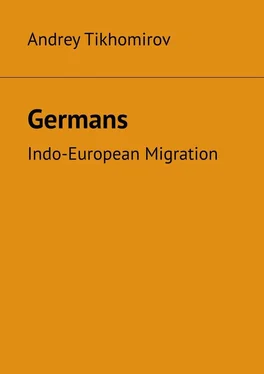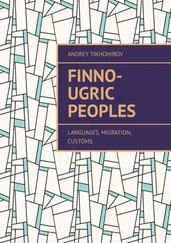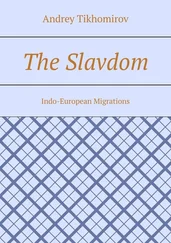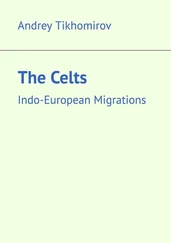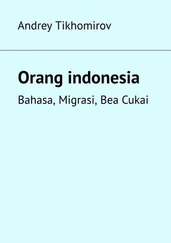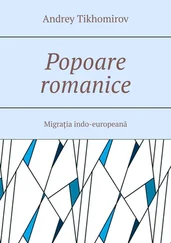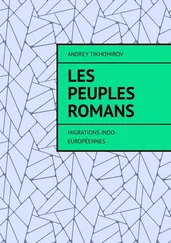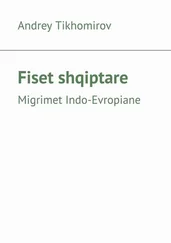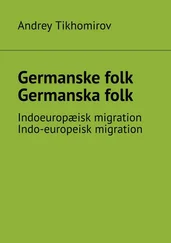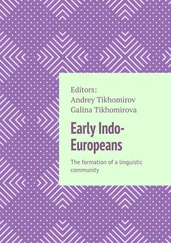Andrey Tikhomirov - Germans. Indo-European Migration
Здесь есть возможность читать онлайн «Andrey Tikhomirov - Germans. Indo-European Migration» — ознакомительный отрывок электронной книги совершенно бесплатно, а после прочтения отрывка купить полную версию. В некоторых случаях можно слушать аудио, скачать через торрент в формате fb2 и присутствует краткое содержание. ISBN: , Жанр: Языкознание, История, на английском языке. Описание произведения, (предисловие) а так же отзывы посетителей доступны на портале библиотеки ЛибКат.
- Название:Germans. Indo-European Migration
- Автор:
- Жанр:
- Год:неизвестен
- ISBN:9785005089809
- Рейтинг книги:3 / 5. Голосов: 1
-
Избранное:Добавить в избранное
- Отзывы:
-
Ваша оценка:
- 60
- 1
- 2
- 3
- 4
- 5
Germans. Indo-European Migration: краткое содержание, описание и аннотация
Предлагаем к чтению аннотацию, описание, краткое содержание или предисловие (зависит от того, что написал сам автор книги «Germans. Indo-European Migration»). Если вы не нашли необходимую информацию о книге — напишите в комментариях, мы постараемся отыскать её.
Germans. Indo-European Migration — читать онлайн ознакомительный отрывок
Ниже представлен текст книги, разбитый по страницам. Система сохранения места последней прочитанной страницы, позволяет с удобством читать онлайн бесплатно книгу «Germans. Indo-European Migration», без необходимости каждый раз заново искать на чём Вы остановились. Поставьте закладку, и сможете в любой момент перейти на страницу, на которой закончили чтение.
Интервал:
Закладка:
This, in particular, is indicated by the fact that wheeled vehicles and domesticated horses appeared in Europe about 5—6 thousand years ago. It is believed that the first people came to Europe from Africa about 45 thousand years ago. About eight thousand years ago, there was a second wave of migration, and Europe was populated by farmers from the Middle East. The third stage of migration, described by scientists, occurred 5—6 thousand years ago from the territories of the European part of modern Russia and Ukraine, and it is with him, according to scientists, that the origin of a number of languages of modern Europe should be associated. The work of scientists confirms the so-called mound hypothesis of the origin of Indo-European languages. Archaeologists and linguists who adhere to it believe that the speakers of the Indo-European proto-language lived on the territory of modern Russia and Ukraine between the Volga and the Dnieper. Supporters of the second most popular hypothesis, the Anatolian, connect the emergence of the Indo-European language family with the migration of people from the territory of modern Turkey (ancient Anatolia) eight thousand years ago. Scientists note that their study allows us to understand how the main Indo-European languages were distributed in Europe 5—6 thousand years ago. However, it does not say anything about the origin of the southern languages of this family, in particular Greek. Now scientists are hoping to understand how the migration of the speakers of the proto-language (proto-languages) and its connection with the Indo-European languages of the Caucasus, Iran and India were organized.
Most characteristic of the end of the 1st millennium BC. e. – the first half of the first millennium A.D. e. archaeological sites in the form of large burial-free burial grounds with various rites of burials: corpses and corpses. The remains after the burning were enclosed in an urn, the corpses were laid in the ground without an urn. So cemeteries were formed, which, as already mentioned above, have been called by archaeologists the name of “fields of burial urns”, or “fields of burials”. In the XIX century. scientists argued about who owned the burial fields discovered in Central Europe – Slavs, Germans, Thracians, or Celts (Indo-Europeans). Such a statement of the question was in itself incorrect, since the rite of burial in the fields of burial urns belonged not only to the tribe, but to all of the tribal masses listed above.
The Czech archaeologist and historian Lubor Niederle, supporting the opinion of P. Schafarik and other Czech and Polish archaeologists, indicated that we can speak of Slavic affiliation only of those monuments of burial fields that are within the limits of the settlement of the ancient Slavic tribes supposed by written sources.
This point of view of L. Niederle regarding the ethnicity of carriers of the culture of the burial fields of Central Europe was confirmed in subsequent works by archaeologists. Polish scholars who studied the culture of the living areas on the territory of Poland, came to the conclusion that the archaeological culture was carried by the Wends, since its territory basically coincides with the territory allotted to the western group of these tribes Pliny, Tacitus and Ptolemy.
Burial fields east of the upper reaches of the Dniester were discovered only at the end of the 19th century. by the famous Russian archaeologist V.V. Khvoika, who examined them in the territory of the Middle Dnieper. The study of the very first monuments of this culture allowed V.V. Khvoika to claim that they belong to the ancient Slavs. The work of V.V. Khvoika was continued by Soviet archaeologists who unearthed and studied many new settlements and burial grounds for the culture of burial fields, which are now known to more than 400. These excavations showed that not only the Middle, but also the Upper Dnieper in the first half of the 1st millennium was settled by Slavic tribes that buried their dead in burial fields and significantly different lifestyles from neighboring tribes – Celts, Thracians and others who had a similar custom of burial. At the same time, it became known that the Slavic tribes of the Dnieper are very close to the Slavic tribes of Hanging. Inside this single massif of Slavic tribes, some local differences are observed, which gave archaeologists the basis to talk about several archaeological cultures. This is the Oksyv culture in the Lower Hanging, the Przeworsk culture in the basin of the Middle and Upper Vistula. The latter is close to the Zarubinets culture of the Slavic tribes of the Middle and Upper Dnieper.
After leaving the steppes of the Southern Urals – Black Sea region, the ancient Germans lived on the territory located mainly between the North Sea, the Rhine, Danube and Laba (Elba), as well as in the south of the Scandinavian Peninsula. The original residence of the Germans in Europe was South Scandinavia, Jutland and the coast of the Baltic and North Seas between Weser and Oder.
Germanic peoples, like other nationalities, evolved by the gradual unification of small tribes into tribal unions and later by the merger of the latter in the nationality. During the VI – I centuries. BC e., gradually moving south, they occupied the territory of modern Germany right up to the Rhine; some tribes, of which the Trevers subsequently played the largest role, crossed the Rhine and established themselves on its left bank. In South Germany, the Sueva, Markomannians and Quads settled most closely in contact with the Celts, with whom they partially mixed.
The Germans formed as a result of the mixing of several races and later mixed with various ethnic groups (Slavs, Celts, Finno-Ugrians, Romanesque peoples, etc.). Until the middle of the 1st century the information of the Greeks and Romans about the Germans was rather scarce. The very name of the Germans, who was originally called the Tungra tribe and which was then appropriated by the Celts to all German tribes, was unknown to ancient authors for a long time. The Germans were divided around the beginning of our era into the Eastern (Goths, Burgundians, Vandals, etc.), Western (Suevs, Hutts, Cherusks, Angles, Saxons, Batavs, Killings, Markomanes, etc.) and Northern (Svions, etc.). Sources for the study of the social system of the Germans are, on the one hand, the data of archeology, comparative linguistics, ethnography, and on the other, the works of ancient authors, especially the Notes on the Gallic War (mid 1 century BC) Julius Caesar, who was directly confronted with the Germans during the conquest of Gaul, and the works of the Roman historian Tacitus – “Germany” (98 AD, the manuscripts called “On the origin and habitat of the Germans”), “Annals” (c. 116 AD) and “Stories” (between 104 and 109 gg.). The Germans of Caesar’s time were already sedentary farmers, but from time to time they abandoned the lands occupied by them and transferred to others. Agricultural machinery was at a low level – a shift agriculture system dominated, requiring large areas of land, arable land was rapidly depleted and changed every 1—2 years. The Germans cultivated rye, oats, barley, and wheat. A large role in economic life was played by cattle breeding and hunting. The Germans at that time did not have private ownership of land: the villages were inhabited by clans, jointly owning the land and collectively cultivating it. By this time, the patriarchal clan had already been replaced by the previously prevailing matriarchal one.
In the 6th century BC e. the merchants of Massalia knew the Tilangian tribe living on the Upper Rhone, later known as the German Tulling tribe. In the middle of the 4th century The massali traveler Pithaeus, in search of the most convenient route to Britain, where lead was mined, and to the Baltic states, from where amber was exported, visited some areas inhabited by the Germans. According to him, north of Britain was land, which he considered an island and called Thule, but which, invisibly, was the west coast of Norway. Pythaeus said that it was inhabited by people engaged in agriculture and collecting honey, from which he made a special drink. Pithaeus also wrote about the island of Abal off the coast of the North Sea, possibly modern Helgoland, and about the Teutons living in the vicinity of this island, in Western Jutland, also one of the Germanic tribes. In the III century. BC e. German Gesat, which means spearmen, served as mercenaries from the Italian Celts, and then from the Romans.
Читать дальшеИнтервал:
Закладка:
Похожие книги на «Germans. Indo-European Migration»
Представляем Вашему вниманию похожие книги на «Germans. Indo-European Migration» списком для выбора. Мы отобрали схожую по названию и смыслу литературу в надежде предоставить читателям больше вариантов отыскать новые, интересные, ещё непрочитанные произведения.
Обсуждение, отзывы о книге «Germans. Indo-European Migration» и просто собственные мнения читателей. Оставьте ваши комментарии, напишите, что Вы думаете о произведении, его смысле или главных героях. Укажите что конкретно понравилось, а что нет, и почему Вы так считаете.
